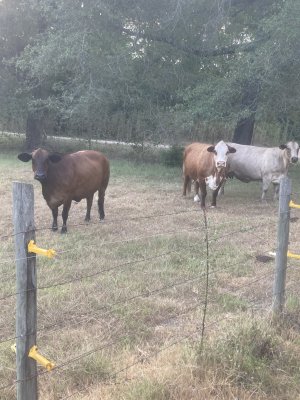SBMF 2015
Well-known member
When we cleaned out my great uncle's house we found an A.I.catalog from the early 70s.I was about 10 years old when the 1st Simmental and Charolais started showing up around here. It was the beginning of a dark period down here, almost a plague or epidemic, that costs us close to half the Angus and Hereford cows down here. The first to arrive in a new place of any breed is usually the bulls. People had not experienced this problem with Brahma, that showed up about the same time, and never considered not breeding their 800 lb cows to these new bulls twice their size. Brahma calves tend to have small heads, compared to what was coming from those Simm and Char bulls with heads the size of a Volkswagon Beetle. By the time I was 16, I had pulled more c;alves, helping the neighbors, than most cow vets have in their entire career. I developed a deep resentment, even hatred, for these bulls that is hard to over come., even now. Always liked Char and Simm cows though. In the mid 70's when fairs first had commercial classes in cow shows around here, a Simm X Char was what you needed to have a shot at winning. These were big ole pale yellow and white cows, that looked just like a simmental that fell in a bleach bath. Heavy milkers that had no problem spitting out Ang and Hereford calves, as well as Brahma calves. In the mid-70's Chiania showed up. Back then, you could not import Chi cows or bulls, only semen. The first Chi cattle I ever saw were Chi-Angus. I think @Jeanne - Simme Valley said that up north, people were AI-ing Brown Swiss with Chi semen. Anyway, there was a man around Griffin, GA, that raised most of the Simm x Char calves for showing. He had some he kept, and he started AI-ing them to Chianina, and what a cross that was! Weaning 6 mos old calves that were 800 lbs...near as big as full grown Angus or Hereford. I just KNEW this was going to be the future of beef cattle, But 1980 came along, and so did CBA, and that was the end of these Simm x Char x Chi's. Plus about that time, as others have said, Angus and Herford over night got as big as Char and Simmental.
Now days, I have gotten over my aversion to Simm bulls, since we now have black Simms. The breeding up of the Simms, especially with Angus, turned them black and polled, and I would as soon use one of them like the 2 @kenny thomas bought from @simme as any Angus I have seen lately.
The Angus bulls had weaning weights in the 300's. The Charolais were in the 6s and 7s. Pretty easy to see how guys would be intrigued to try the new continental breeds.

